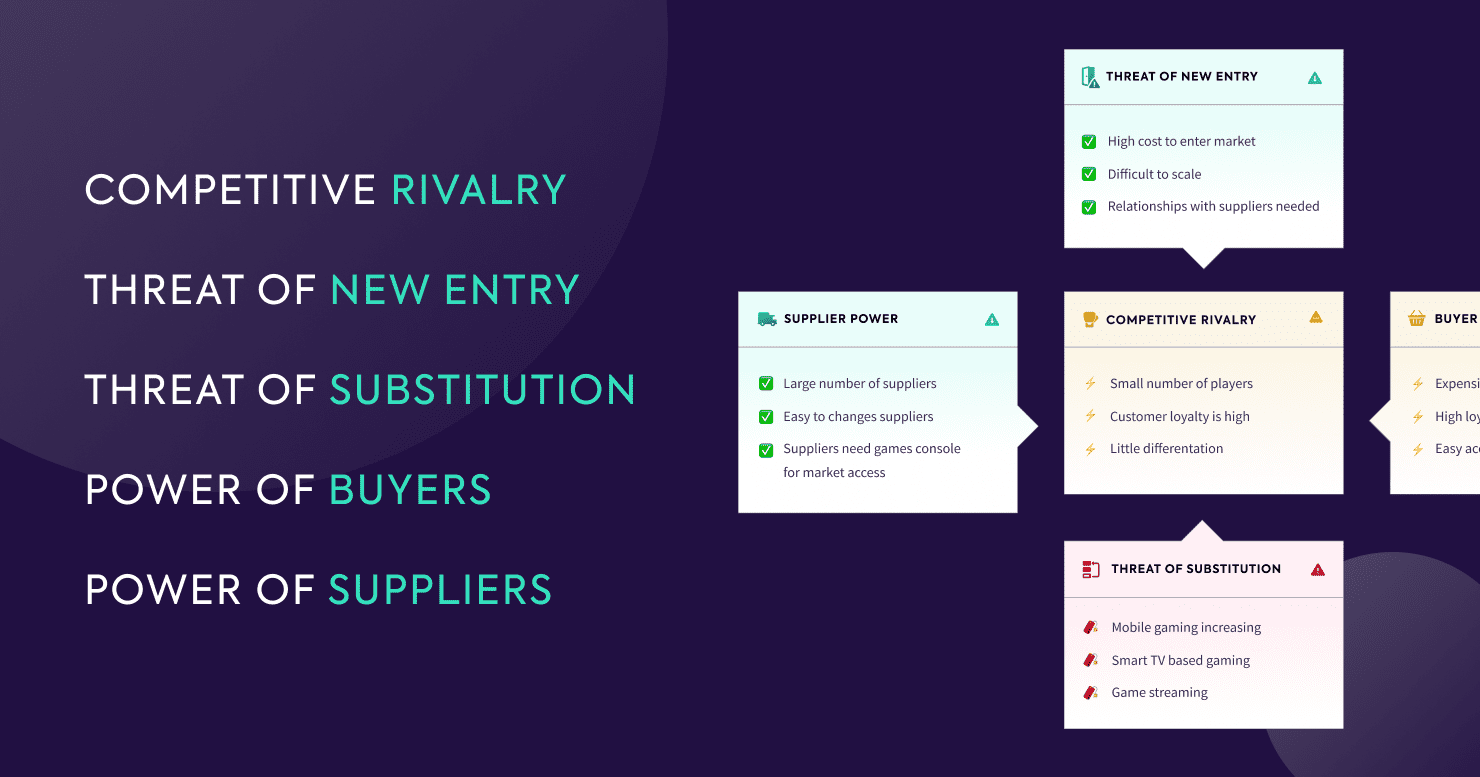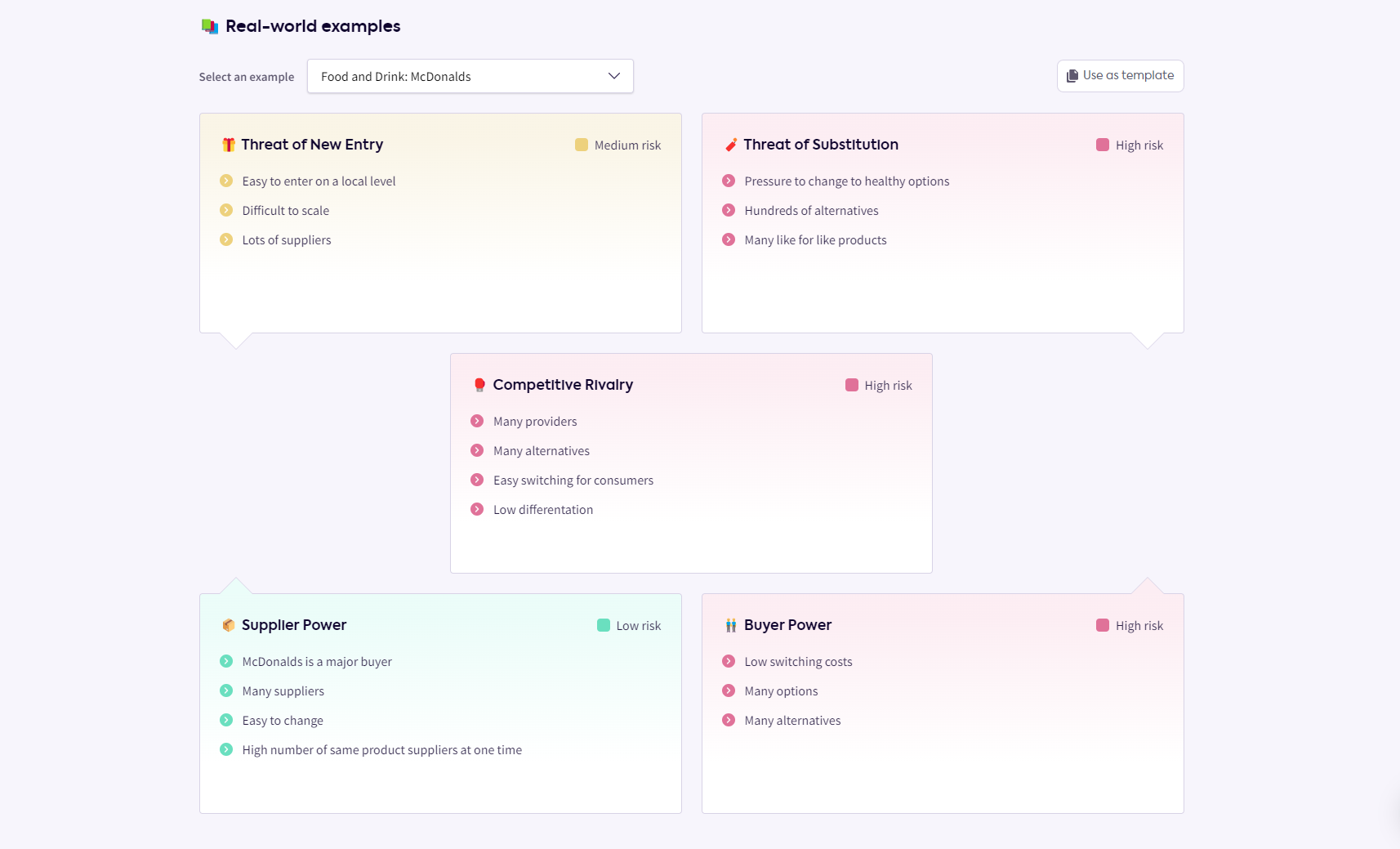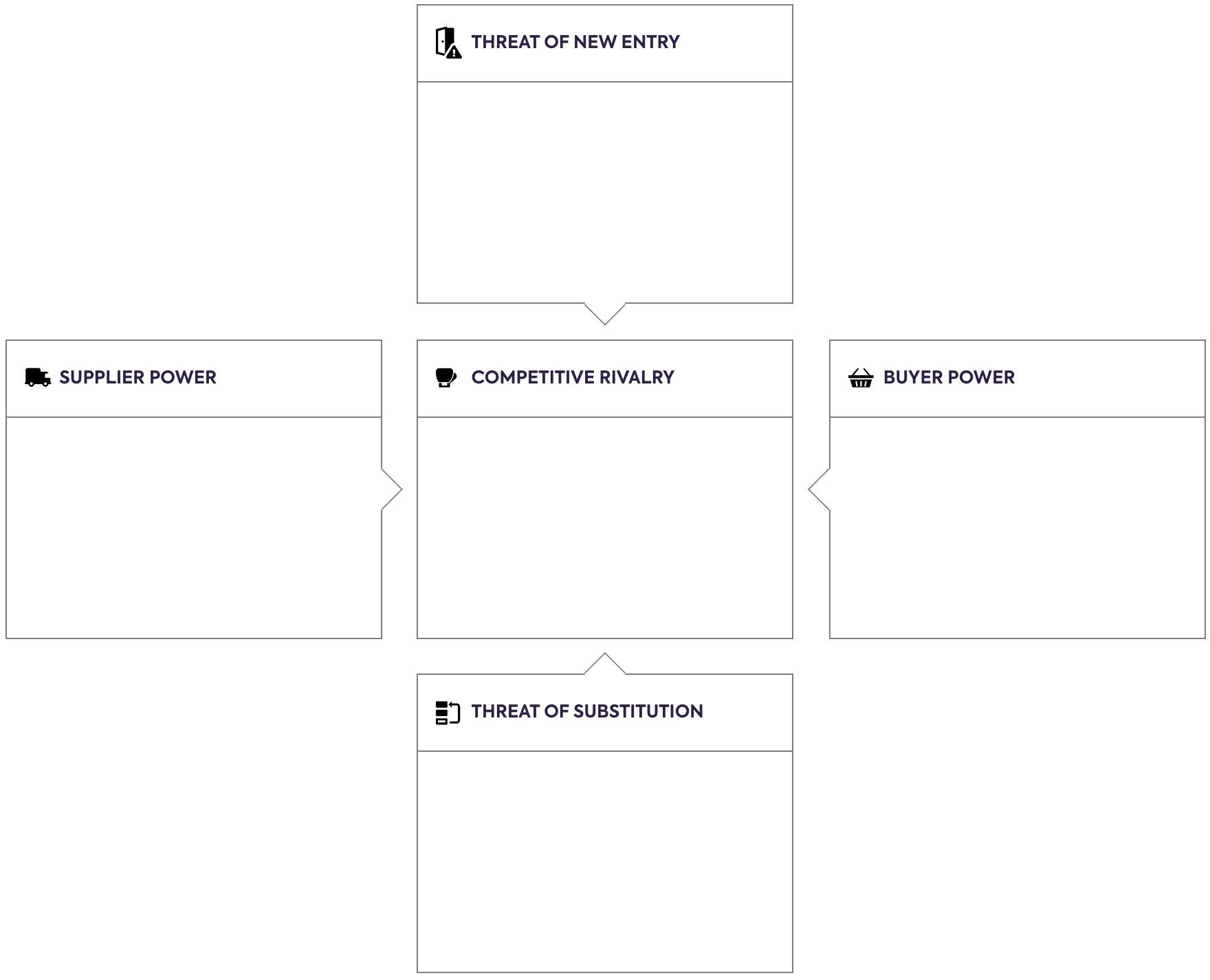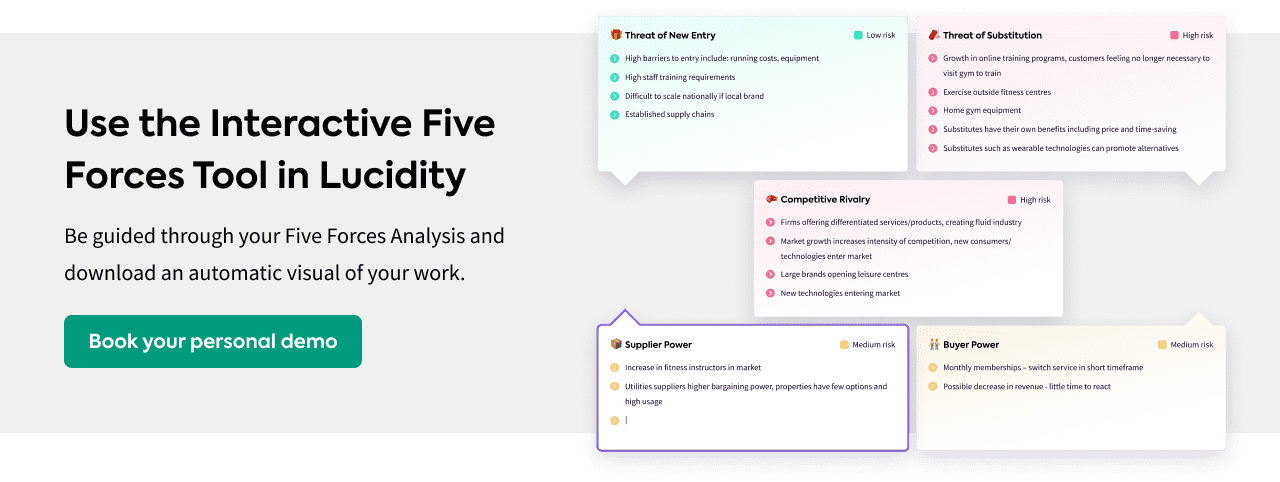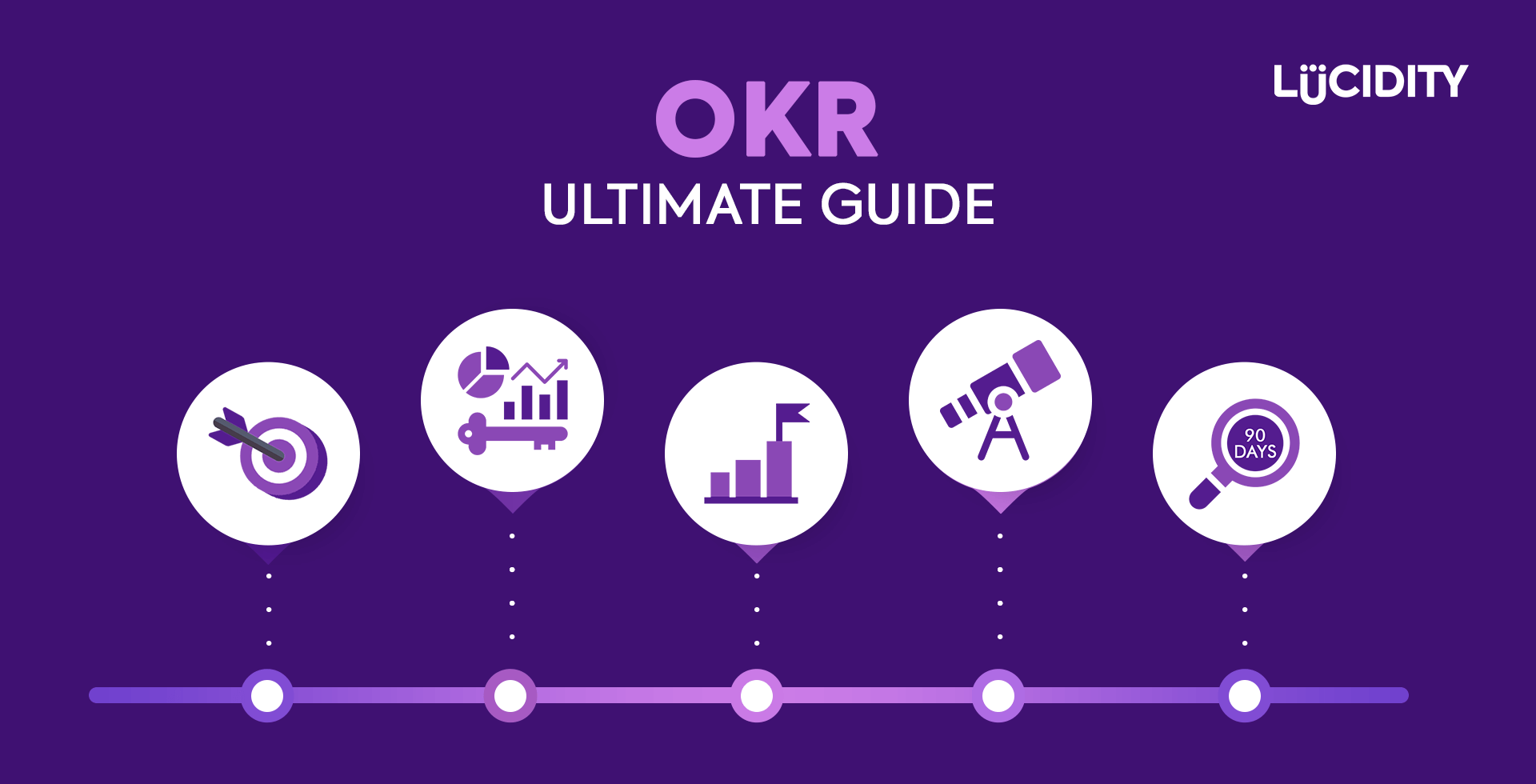This is the only guide you’ll ever need for Porter’s Five Forces with guides, examples and more…
Porter’s Five Forces is a framework to analyse the potential profitability of a marketplace. It was invented by Michael Porter in 1979 and has been used consistently by thousands of companies across the world since originally being published.
Five Forces looks at five key areas in a market that impact your price and profitability. The forces analysed are:
- Power of Buyers
- Power of Suppliers
- Threat of Substitutes
- Threat of New Entrants
- Competitive Rivalry
Each of the above is rated High, Medium or Low. Ideally, you want all forces to be low. This gives you the most flexibility and control. If every force is high, you have some issues and need to take action in order to improve your position and profitability.
In this guide we’ll answer the common questions about Five Forces, look at how to create a Five Forces model for your business, provide a video on the process, cite examples, and look at how some people extend to a sixth force. It’s the ultimate way to understand the profitability of your marketplace.
Beginner Guide to Five Forces
Link: An Introduction to Porter’s Five Forces Analysis
This is the best place to start if you’re new to Five Forces and haven’t heard of the model before. It’s a great introduction article that covers all the common questions and topics around Five Forces to get you up to speed before you begin to perform the analysis on your own company. The resource covers:
- Definition of Porter’s Five Forces
- Example structure and diagram
- Advantages and limitations of the model
- Preparation advice and tips
- History of the model
- Breakdown of each force and how they interlink
If you’ve used Five Forces before then you can skip this resource and continue through the guide, but if this is the first time you’ve encountered the model be sure to check out this introduction article:
Creating a Five Forces Analysis
Link: Create a Porter’s Five Forces in 6 Steps
There is also the video will take you through developing your own Five Forces model. At the end of it you’ll have a list of areas holding your growth back, risks that impact your company, and considerations for the future. It’s a really effective toolkit and one that all companies should use at some point to inform their strategic decisions.
Five Forces is a framework to analyse one marketplace, so you may want to run this model a few times if you’re in different markets or provide different products. This article will help you produce the best possible Five Forces, putting you in a great position to move the business forward and address your market challenges.
Porter’s Five Forces Examples
Every Five Forces Analysis is different because it’s always very specific to a market. Despite this, examples always help you consider factors in your own market. There may be shared attributes with your industry or it may stimulate your own thinking.
It’s always worth looking at previous work people have done if you’re about to do a Five Forces. You’ll find many examples in Lucidity, of course, but we’ve also pulled together some different resources:
The Body Shop:
A look at the different forces for the market of The Body Shop.
Leisure Centre:
Five Forces evaluation for an independent Leisure Centre.
Mars Confectionery:
An investigation into the market forces for Maltesers.
eBay:
Various forces at play that impact auction site eBay.
IKEA:
What forces in the UK market impact Sweden’s flagship furniture company?
easyJet:
A look at how the forces that impact the aviation giant.
As you go through these examples consider how each one is rated High, Medium, or Low. What similarities are there with your own markets, and are you comfortable with how you rate your own forces?
Five Forces Toolkits
There are a number of ways you can map out your Five Forces Analysis, despite the somewhat unusual diagram normally associated with the model. It often looks like this image:
Word & Excel:
Five Forces in Word and Excel is often relegated to becoming a long list of items under certain headings which, while effective and scalable, is not interesting or engaging. It tends to look more like a Risk Assessment than a market analysis framework and can lead to difficulties around consistency and version control.
PowerPoint:
PowerPoint does a more effective job of Five Forces than it’s Office siblings. The slides allow you to create the model on a single page and enter the data in a way that allows the end user to review all the forces in one place. The disadvantages of Word and Excel are somewhat shared though, in that you’ll still have issues of consistency and version control. It’ll also likely get buried in some cloud-based document folder, never to be found again…
Whiteboard:
Five Forces lends itself to group discussion, as you want to have market experts from sales and marketing in the room. You’re examining the external market in quite a bit of detail and the impact on your operations, so a whiteboard can be an effective way to capture the information. What you do after that though can be problematic, as you need to summarise and communicate your findings.
Five Forces Software:
Software for Five Forces is the best option, it allows remote collaboration, capturing of information, and a direct link to your strategy plan. Check out Lucidity strategy software for a great example of Five Forces, including an easy to use wizard and management tools… yes, we’re going to blow our own trumpet! 🎺
Five Forces Video Guide:
Link: Five Forces Video Guide
We understand sometimes it’s easier to watch a 3-minute video than read a whole guide, so we’ve done exactly that. The below video includes:
- Definition of Five Forces
- Preparation required
- Example Competitive Rivalry factors
- Example Threat of New Entry factors
- Example Threat of Substitution factors
- Example Supplier Power factors
- Example Buyer Power factors
We’re working on an IMAX version coming to your local cinema…
Five Tips on Five Forces
There’s a strong theme of the number five today, so here are five top tips around completing Five Forces…
“The basic idea of the competitive forces starts with the notion that competition is often looked at too narrowly by managers. Five Forces say yes, you’re competing with your direct competitors, but you’re also in a fight for profits with a broader extended set of competitors – customers, suppliers, new entrants, substitutes.”
Michael Porter, interview from HBP
“The thing to remember is that Porters Five Forces is all about understanding likely profitability in a marketplace. Once you appreciate that, its a great tool to understand the pressures going on within a marketplace and how you can mitigate those things – through product development, pricing strategies, buying strategies, marketing activity etc and of course these ideas end up in your strategy and help you move forward and grow.”
Tom Ricca-McCarthy
“Five Forces is detailed enough to really identify your weakest points in a market and so helps you plan on how to adapt and improve. Make sure you involve people from across the business as the 5 forces are distinct and you need input on each one to really nail this analysis.”
Mike Fahey
"I take all new marketing team members through a Five Forces analysis of our marketplace when they join the company. It’s a very quick way of helping them to understand the environment we’re operating within. Of particular importance for the marketing team is the competitive rivalry force. A marketer needs to understand how competitors interact and co-exist within their space so they can devise the right marketing strategies and tactics to bring success. For example, you cannot get your positioning and messaging right without understanding how competitors differentiate themselves. Also, a marketer needs to know if they are defending market-share or trying to win it – the tactics will be different! They need to know if there are lots of other providers in the space and how easy and commonplace is it for customers to switch between them – that will influence how they allocate budget and focus between retention campaigns and lead generation. The list goes on!"
Megan Saker
"Five Forces is a model easily understood and frequently used by business students. It’s a popular tool for analysis of a marketplace precisely because of its ease of use. Breaking down the analysis into these five different components makes the task of assessing the viability of a marketplace less daunting and more easily managed. Of course, using the model in an academic setting is one thing, but if Five Forces is going to be a useful tool to inform a business’ strategic plan, then it’s important to book in a follow-up session with your leadership team and go through each section of the model discussing where there may be opportunities, where you need to strengthen your product or service, where you need to focus your marketing efforts and where you need to make changes to capitalise on any growth potential."
Hugh Varilly, Visiting Professor at University College London
Full List of Five Forces Factors
To help kickstart your analysis on Five Forces here’s a list of the factors you should be considering.
Competitive Strategy / Rivalry
- Range of products and services offered
- Brand loyalty
- Number of competitors in market
- Ease of switching between providers
- Market growth rate
- Industry lifecycle point
Power of Buyers
- Number of buyers and market size
- Value of each buyer
- Switching Costs – Ease of switching to competitor
- Number of options for buyers
- Alternative options for buyers
- Sensitivity to price points
- How key is product or service to buyer
- Barriers to entry
Power of Suppliers
- Number of suppliers in market
- Size of suppliers in market
- Risk of supplier moving into your market
- Cost point of suppliers
- Threat of substitute products – Substitution options for the supplier product or service
- Ease to move between suppliers
- Differentiation of suppliers offering
- How big a customer you are to the suppliers
- Bargaining power of suppliers
Threat of New Entrants
- Brand reputation
- Customer loyalty
- Your differentiation
- Market growth rate
- Entry capital requirements
- Economies of scale
- Logistics and distribution networks
- Skills requirements
- Ease of access to technology
- Input requirements
- Operational margins
- Industry knowledge requirements
- Government regulation
- Ease for customers to move provider
Threat of Substitution
- Current substitute products on offer
- Reasons for buyer churn
- Price of substitute vs product or service
- Quality of substitute vs product or service
- Cost of switching
- Usage trends
- External trends (consider PESTLE…)
Real Life Usage – Diversification with Five Forces
Link: Diversification Strategy Guide
Link: Diversification Strategy Webinar
Five Forces can be a great tool when you’re looking at markets to diversify into, as alongside Porter’s Three Tests you’ll find them a helpful way to establish the profitability of the potential market. If you’re considering diversification then check out this resource and also watch the webinar that discusses the process.
Adding A Sixth Force to Five Forces
There’s a model used to extend Five Forces imaginatively called Six Forces. It looks at something called Complementor Products, these are other products or services that directly impact your own. The common example being if Apple release a new iPhone, any business that produces iPhone cases is impacted positives (more sales) and negatively (new design required).
There are a couple of articles that will help you think about the Six Forces.
Link: Introduction to Six Forces
If you’re looking for an introduction to the whole concept fo Five and Six Forces, this is the article for you. It covers:
- All six forces in detail
- Advantages and disadvantages
- Preparation and advice
- History of the model
- Example diagram
Link: How to create a Six Forces Analysis
Ready to add a Sixth Force to your Five Forces analysis? Then this is the resource for you. It covers:
- The Sixth Force called Complementor Products
- Examples and considerations
- Key questions
- Possible next steps
Six Forces isn’t as popular as Five Forces but it can be a more useful model depending on your market. Consider which may be best for you before you embark on the analysis.
Summary
This concludes our guide to Five Forces and Six Forces, some of the most effective ways to examine the factors that impact your marketplace. Work through our own versions of Five Forces and see how many are High, Medium, or Low. Are you in a strong position or a weak position?
Feed your results into your SWOT Analysis and, together with PESTLE Analysis, you’ll have an extensive look at your marketplace.
